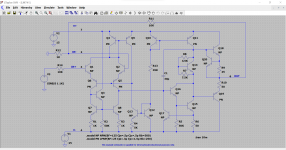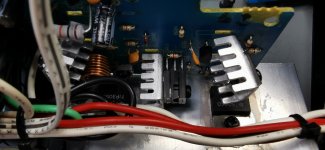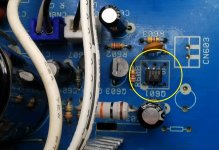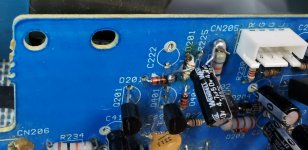Just out of curiosity realy, picked this up for less than £20, powers on ok, no blown fuses, but no sound, just hum
never seen transistors mounted like this before
never seen transistors mounted like this before
Attachments
Last edited:
Disconnect the input to the amplifiers, CN601 + 801 or CN205, does it still hum?
DC on the speaker terminals?
Mounting the transistors on a stack ensures good thermal connection between the driver transistors and the bias voltage transistor.
DC on the speaker terminals?
Mounting the transistors on a stack ensures good thermal connection between the driver transistors and the bias voltage transistor.
Many transistors are available in different pinouts, maybe this board is just "brand flexible" and different versions of the part can be used?
its ok i realised just now that whoever worked on it last was too lazy to do it properly
that 1.5m ohm goes in R225
that 1.5m ohm goes in R225
so this is all fixed now and took me round the houses a bit,as there were multiple problems, but with a bit of help from that diamond admin mooley,i got there in the end.
there was a broken track, which was fragmented under the shellac on the board and i only found by accident realy when i was prodding around, and the op-amp turned out to be the final culprit, but other faults found were with the power amp-output transitors gone on one channel and both filter caps were leaking from the top very slightly-these were replaced with slightly higher voltage ones
rest of the caps were ok apart from C612, a poly cap leaking to ground
2 of the resistors were faulty
R605 and R609
Actualy generaly quite a well built unit, if a bit difficult to work on at times, nice board,nice track and the original components were all pretty good makes
phillips op amp
cornell dubilier caps
Now for the realy suprising bit
It is a REALY good sounding amp. Im quite privaliged get to listen quite a few different ones and compare them.
This is up with NADS 3020 ser 20-no problem
and so onto the next one 👍
there was a broken track, which was fragmented under the shellac on the board and i only found by accident realy when i was prodding around, and the op-amp turned out to be the final culprit, but other faults found were with the power amp-output transitors gone on one channel and both filter caps were leaking from the top very slightly-these were replaced with slightly higher voltage ones
rest of the caps were ok apart from C612, a poly cap leaking to ground
2 of the resistors were faulty
R605 and R609
Actualy generaly quite a well built unit, if a bit difficult to work on at times, nice board,nice track and the original components were all pretty good makes
phillips op amp
cornell dubilier caps
Now for the realy suprising bit
It is a REALY good sounding amp. Im quite privaliged get to listen quite a few different ones and compare them.
This is up with NADS 3020 ser 20-no problem
and so onto the next one 👍
but with a bit of help from that diamond admin mooley,i got there in the end.
Why thank you kind Sir 🙂 If you fit a socket for the opamps you could try some different ones and see if you think you prefer one over another.
(Please make all cheques payable to Barclays....)
You would have to try it for yourself. Opamps do sound different and that is no surprise really when you look at what is in one because it is really a small complete amplifier in itself.
If you look in your Document folder and look at the LTspice Folder there is a folder in there called 'Examples'. Open the folder and click on 'Educational' and there is a 741 opamp in the list. You'll see it looks very much like a proper amplifier. Run the sim, it all works.
So different opamp sound different. I always liked the TL072 FET series. The LM4562 is a the modern replacement for the NE5532. The 4558 is a jelly bean opamp and the 1458 is a dual 741. So trying a 1458 (to see what the worst sound like) is good to do.

If you look in your Document folder and look at the LTspice Folder there is a folder in there called 'Examples'. Open the folder and click on 'Educational' and there is a 741 opamp in the list. You'll see it looks very much like a proper amplifier. Run the sim, it all works.
So different opamp sound different. I always liked the TL072 FET series. The LM4562 is a the modern replacement for the NE5532. The 4558 is a jelly bean opamp and the 1458 is a dual 741. So trying a 1458 (to see what the worst sound like) is good to do.

Yeah I will give it a go. Is it a common base that you get to convert? I presume some kind of piggy back job
They are a socket you fit and then you can try different ones. The socket can be left as a permanent fixture.
These:
https://cpc.farnell.com/multicomp/spc15494/dip-socket-8pos-2row-2-54mm-th/dp/SC15358?st=ic socket

When you remove an IC from a socket you do it by levering it up a little at a time from each end with a small screwdriver. It you try and remove it without easing it out a little at a time from each end then it will suddenly pop out and bend all the pins in the process while most liking stabbing you in the finger with half the pins at the same time.
These:
https://cpc.farnell.com/multicomp/spc15494/dip-socket-8pos-2row-2-54mm-th/dp/SC15358?st=ic socket

When you remove an IC from a socket you do it by levering it up a little at a time from each end with a small screwdriver. It you try and remove it without easing it out a little at a time from each end then it will suddenly pop out and bend all the pins in the process while most liking stabbing you in the finger with half the pins at the same time.
- Home
- Amplifiers
- Solid State
- AMC 3020 repair


